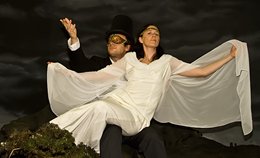The road to the present in any Irish town is paved with colourful events, brave, tragic and notorious characters and the fight for freedom, whether personal or political. John Sheehy’s “world premiere”, Set in Stone is a condensed history of Kilmallock from its 1569 Fitzmaurice siege to its busy thoroughfare of people and vehicles going about their daily lives in 2010, recession or no recession. Limiting the audience to a maximum of forty, Call Back Theatre organise a congregation at Kilmallock’s beautiful Dominican Abbey before leading on to Friar’s Gate Theatre where the inventive prologue to the story begins with a mother and bawling child on a stark white stepped platform surrounded by clocks. The atmosphere is ethereal and surreal: “Mother” dressed in white and fanning the child (also swaddled in white) is more symbolic than real mother, giving an immediate sense of theatricality. Does she represent the white page and the child the audience, to whom “Father”, sitting on his chair, dressed in black and wearing a face mask, will tell this bedtime historic story?
 The long tale unfurls in promenade style as the audience is ushered from space to space, firstly into the front room of a young couple who in 1569 argue about their leaving of Kilmallock, not knowing whether or not they will return. The personal trauma of the story behind their sacrifice is depicted here. Skip on two centuries to the faction fight of 1750 which is re-enacted with stones in socks, sticks and a bric-a-brac of deadly utility tools upon another impressive stage setting of bleak boulders. The use of strobe lighting for the fight scene is stunningly effective in maximising the brutality of the bloody brawl.
The long tale unfurls in promenade style as the audience is ushered from space to space, firstly into the front room of a young couple who in 1569 argue about their leaving of Kilmallock, not knowing whether or not they will return. The personal trauma of the story behind their sacrifice is depicted here. Skip on two centuries to the faction fight of 1750 which is re-enacted with stones in socks, sticks and a bric-a-brac of deadly utility tools upon another impressive stage setting of bleak boulders. The use of strobe lighting for the fight scene is stunningly effective in maximising the brutality of the bloody brawl.
One of Kilmallock’s infamous daughters is Lola Montez, whose sobriquet “The Spanish Dancer” accompanied her reputation as socialite, tempestuous temptress and mistress of King Ludwig I of Bavaria. The illegitimate daughter of one of Kilmallock’s Castle Oliver aristocrats, she gained notoriety as a socialite throughout Europe, the eastern States of America and even stirred a storm in Australia. Her story has inspired movies and musicals. Sheehy here gives her a platform to tell her story from her own point of view. Like every aspect of this production, it is done in a fantastic, ostentatious but ultimately professional style that is seductive, entertaining and informative.
There is so much to praise about this play in its devising, execution and drama. It switches expertly from coarse and rough depictions of life through the centuries to the velvety texture of opulence as in the Lola Montez scene. Asking four actors to cover half a millennium, inhabit and swap a myriad of characters and situations, and to move venues within the theatre for six scenes while taking the audience with them is no small order. It leaves ample room for disaster but was achieved flawlessly and the audience appreciated every moment. Aoife O’Sullivan’s stage management and Davy Dummigan’s set and costume design deserve praise for ingenuity and resourcefulness. Eoin Winning’s and Jeff Lane’s lighting superbly dress the various scenes.
Sheehy’s direction remains firmly in control. Between the mother and child prologue and the epilogue, he tells six individual stories. His imaginative focus requires seismic shifts both in the writing and directing, but his vision for each piece is clear and precise and realised by a well chosen, terrific cast. The talented quartet revel in every scene and character change, imbuing life into each story with passionate and distinct performances. From siege to faction fight to the scandalous Lola to the young James Walsh sent to the gallows in 1862, on to the Fenian attack on a police barracks in 1867 to the 1924 gold rush scene, Sheehy and cast recount the events and the human stories behind them in a captivating carnival of drama, based on great writing and smart humorous dialogue.
Breda Shannon is a freelance writer and reviews books for The Irish Examiner.